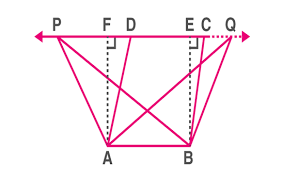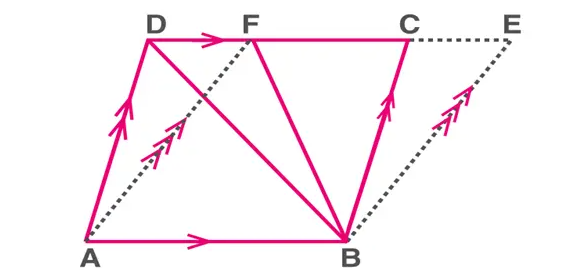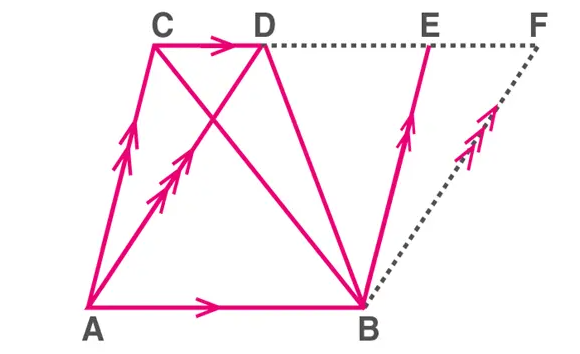Areas Of Parallelograms And Triangles Class 9th Notes - Free NCERT Class 9 Maths Chapter 9 Notes - Download PDF
Areas Of Parallelograms And Triangles class 9 notes:
The Areas Of Parallelograms And Triangles is the NCERT chapter which deals with The quantity of space inside the edge of a 2D object is referred to as its area. It's a measurement that expresses the size of a two-dimensional figure or shape. Its units are cm2, m2, hectare, acre, and so on. As a result, the area of a figure is a number in some unit related to the section of the figure that is enclosed. The NCERT Class 9 Maths Chapter 9 Notes covers a brief outline of the chapter Areas Of Parallelograms And Triangles. The main topics covered are Introduction, Same Parallels and on the Same Base, Area of a parallelogram, Area of Triangle, Theorems -Parallelograms on a Common Base and Between the Same Parallels, Triangles with the Same Parallels and a Common Base, Two triangles with the same base and the same area, Between the same parallels, a parallelogram and a triangle in the Areas Of Parallelograms And Triangles class 9 notes with some FAQs.
The basic equations in the chapter are also covered in the class 9 maths chapter 9 notes. All of these topics are covered in Areas Of Parallelograms And Triangles class 9 notes pdf download. In the CBSE class 9 maths chapter 9 notes, the required derivations are not addressed. No, the notes for class 9 maths chapter 9 do not include all of the important derivations. This NCERT note summarises the chapter's important points and equations and can be used to review Areas Of Parallelograms And Triangles.
Also, students can refer,
NCERT Class 9 Maths Chapter 9 Notes
Introduction
A closed geometric figure's area represents the amount of planar surface it covers.
Same Parallels And On The Same Base
If: a) They have a common side, two shapes are said to be on the same base and between the same parallels.
b) The vertices opposite the common side are on the same straight line parallel to the base as the sides parallel to the common base.

example: Rectangle ABEF, Parallelogram ABCD; and Triangles ABP and ABQ
Area of Parallelogram:
A = b x h
The base is 'b′, and the equivalent altitude is 'h′. (Height).
Area of Triangle:
A = ( 1/2 ) b x h
The base is "b," while the equivalent altitude is "h."
Theorems
Parallelograms On A Common Base And Between The Same Parallels
If two parallelograms have the same base and lie between the same parallels,
a) They are said to be on the same base.
b) The sides parallel to the same side are parallel to each other.

Theorem: Areas of parallelograms lying on the same base and between the same parallels are equal.
Here, area ( parallelogram ABCD ) = area ( parallelogram ABEF )
Triangles With The Same Parallels And A Common Base
If a) They have a common side, two triangles are said to be on the same base and between the same parallels.
b) The vertices on the opposite side of the common side are parallel to the common side.

Theorem: Triangles that share the same or common base and are connected by the same parallels have the same area.
Here, area ( ΔABC ) = area ( ΔABD )
Two Triangles With The Same Base And The Same Area
When two triangles have the same base and area, their associated altitudes are the same.
Between The Same Parallels, A Parallelogram, And A Triangle
A triangle and a parallelogram, are said to be on the same base and between the same parallels.
a) Have the same side
b) The vertices on the opposite side of the common side are parallel to the common side.
Theorem: If a triangle and a parallelogram have the same base and are connected by the same parallels, the triangle's area equals half that of the parallelogram.
Here, area ( ΔABC ) = ( 1/2 ) area of parallelogram ABDE
Significance of NCERT class 9 maths chapter 9 notes
The Areas Of Parallelograms And Triangles in class 9th notes will help you review the chapter and gain a sense of the main points presented.
This NCERT class 9 maths chapter 9 notes can be used to cover the core concepts of the CBSE maths syllabus in class 9 as well as for competitive exams like VITEEE, BITSAT, JEE Main, NEET, and other similar exams.
NCERT solutions of class 9 subject wise
NCERT Class 9 Exemplar Solutions for Other Subjects:
NCERT Class 9 Notes Chapter wise
Popular Questions
Courses After 12th
Applications for Admissions are open.
As per latest syllabus. Physics formulas, equations, & laws of class 11 & 12th chapters
JEE Main Important Chemistry formulas
Get nowAs per latest syllabus. Chemistry formulas, equations, & laws of class 11 & 12th chapters
JEE Main high scoring chapters and topics
Get nowAs per latest 2024 syllabus. Study 40% syllabus and score upto 100% marks in JEE
JEE Main Important Mathematics Formulas
Get nowAs per latest syllabus. Maths formulas, equations, & theorems of class 11 & 12th chapters
